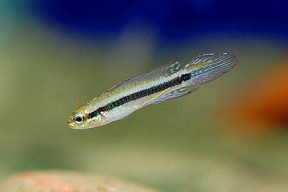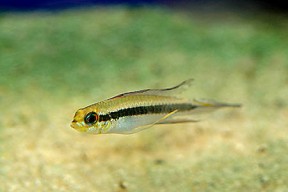Taeniacara candidi
Classification
Cichlidae. Subfamily: Geophaginae
Distribution
Native to Brazil, where its range extends from the lower Rio Negro along the Amazon as far as the Rio Tapajós.
Habitat
Native to Brazil, where its range extends from the lower Rio Negro along the Amazon as far as the Rio Tapajós.
Maximum Standard Length
Males: 2.5″, Females: 2″
Aquarium SizeTop ↑
18″L x 15″W x 12″H (45cm x 37.5cm x 30cm) – 53 litres
Maintenance
Taeniacara candidi require a densely planted tank with plenty of hiding places (these can be covered by bits of driftwood, bogwood, mopani wood or clay/plastic garden pots).
Water Conditions
Temperature: Candidi prefer higher temperatures – 81 to 86°f (27 to 30°c).
pH: Very acidic – 4.5 to 5.8
Hardness: Very soft, usually no more than 1°dH.
Diet
Taeniacara may not accept dried food. Make sure a varied diet of frozen foods are given, though live foods will undoubtedly be preferred. Be prepared to find an easily renewable source of live foods for this fish.
Behaviour and CompatibilityTop ↑
Taeniacara Candidi are said to be one of the most aggressive dwarf cichlids around. Some reports intone that the male is hyper-aggressive, whereas other reports tell of the female being the boss of the Candidi setup. If more than one male is placed in a tank smaller than 48″, it is highly likely that the dominant male will kill all of the other males.
Sexual Dimorphism
Males are bigger with more vivid patterning, females are smaller but still possess a blue-spotted caudal fin.
Reproduction
Some reports indicate that breeding Taeniacara Candid is extremely difficult. However, there have been frequent reports of Candidi breeding in the home aquarium. Some people have had luck breeding this species of Taeniacara in water with pH as high as 7, but it is generally accepted that a very acidic pH combined with very low GH will be required to breed Taeniacara Candidi.
NotesTop ↑
Taeniacara Candidi are the source of much discussion amongst dwarf cichlid keepers. They are a highly attractive species, but require very specific water parameters and as such are seen as a challenge amongst even experienced south american cichlid keepers.
Candidi are renowned for not liking water changes – they will commonly get “moody” after a water change, and will sulk at the bottom of the tank for over a day in some cases. Try to keep new water at the same temperature as the Candidi tank (this can be achieved by using an aquarium heater with a thermostat in a bucket of water for a few hours before siphoning into the tank).
The genus Taeniacara is still under consideration – this fish was once known as Apistogramma weisei and it may be that in the near future, it will be part of the Apistogramma genus again. This fish exhibits similar behaviour to species of the Apistogramma genus, with the mother of a spawn guarding the fry very aggressively. Taeniacara Candidi possess a slimmer body than most of the Apistogramma genus, but are equally attractive.



